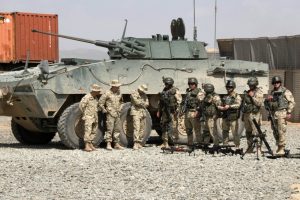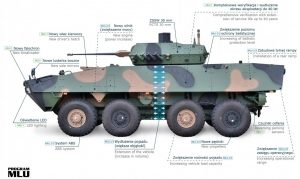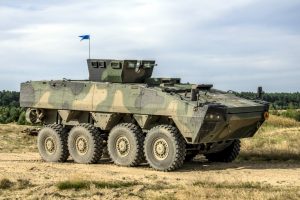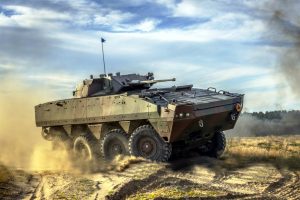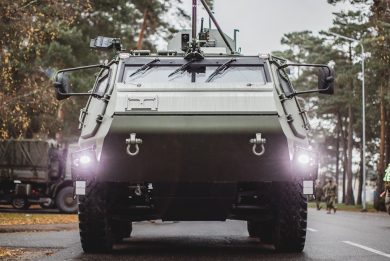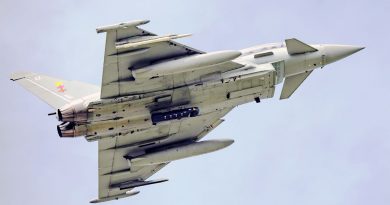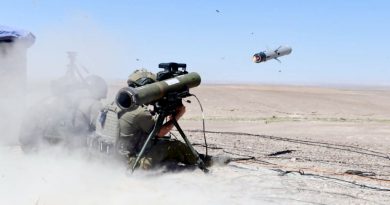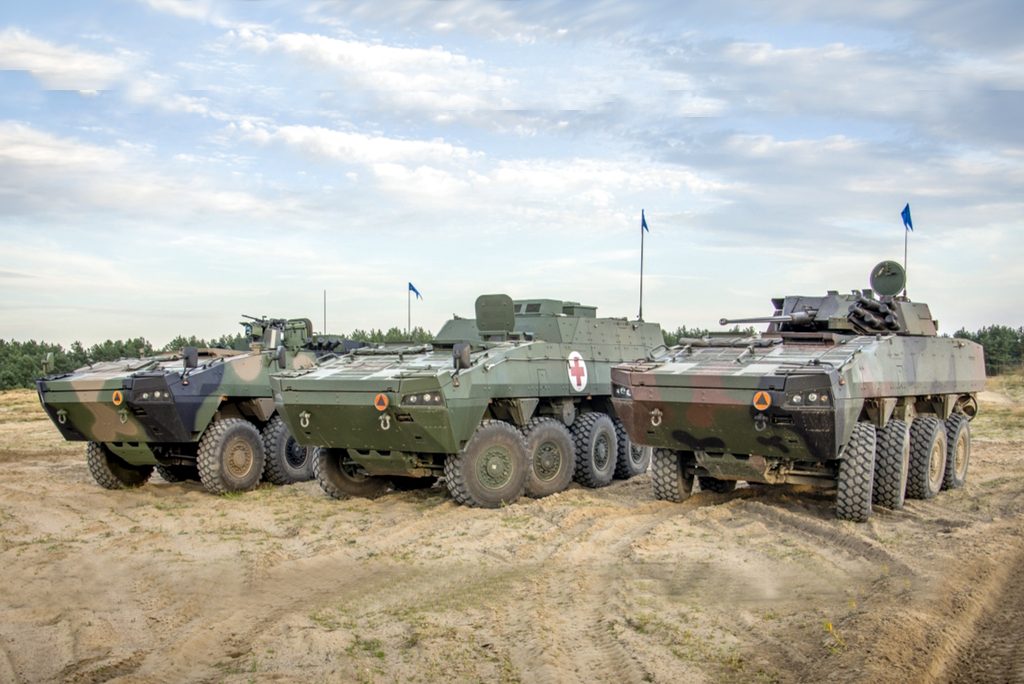
Long life to the Rosomak 8×8: the Polish MLU programme
The Rosomak 8×8 armoured personnel carrier, the Polish derivative of the Finnish Patria AMV 8×8 armoured personnel carrier, was the first western armoured vehicle to enter service in big numbers with the Polish Army, the contract having been signed in 2003 with production starting in 2004. Around 900 vehicles are currently in service in 13 different versions, Combat proven in Afghanistan, Polish statistics speak of around 100 lives saved by that vehicle, it is produced in Siemianowice Śląskie, on the northern outskirt of Katowice, by Rosomak SA, which 99.59% of the shares are owned by PGZ, the Polish Armament Group, and is responsible for the design, production, training, repair, spares, as well as for solving the current logistic chain breakdown,
At the recent MSPO exhibition in Kielce, Rosomak SA unveiled its Mid Life Upgrade (MLU) proposal for the vehicle, which first platforms entered service well over 15 years ago. At the Armoured Vehicles Eastern Europe conference, organised by Defence IQ in Warsaw last 27-28 September, Artur Kopczyński, R&D Director at Rosomak SA, further detailed that programme, underlining that the vehicle evolution will be based mostly on lessons learned from the Polish Army during its training and operational activities.
“The main focus is to extend the life of the existing fleet, while optimising its design at the best moment into its life, when future exploitation will be maximum,” the Rosomak representative explained. “The MLU programme is divided into three packages, the first one, MLU 1, including a thorough technical check of the vehicles that will lead to the replacement of worn out components, due to the intensive use.” Mostly an obsolescence-solving programme, it aims at quickly bringing back existing vehicles in full operational status. “The second package proposed, MLU 2, includes deep modifications of the Rosomak, main ones being increasing the vehicle length, replacing the powerpack, adopting an improved ballistic protection, and replacing rear doors with a ramp,” Mr. Kopczyński said. MLU2 will obviously include all MLU 1 activities. “As for MLU 3, this will in fact not be an improvement but the production of new vehicles at the MLU 2 new standard.”
All Polish Rosomak 8×8 vehicles were produced with double hinged rear doors, which are not the best solution for quick ingress and egress, therefore the request to replace them with a ramp was one with the highest priority. Another key issue was the increase of volume; to obtain this a 0.4 meters section will be added at the centre of the vehicle, between axles two and three, increasing the protected volume by 1 m3. The weight increase was not declared, however the speaker at the Armoured Vehicles Eastern Europe conference stated that buoyancy was improved, Polish Rosomak having amphibious capability, which is considered a key issue by the Army. “The current Rosomak can carry out amphibious operations at a maximum weight of 23.5 tonnes while industry tests have shown that the new stretched version can operate at 25.5 tonnes,” Mr. Kopczyński declared, adding that this has yet to be proven by the Army. Powered in the water by two ducted propellers located at the rear, the basic Rosomak can reach a maximum speed of 10 km/h afloat, while in non-amphibious operations its gross vehicle weight is 26 tonnes. The improved amphibious capabilities are due not only to the increased volume but also to the adoption of new propellers as well as a new trim vane; “We have tested different solutions with the aim of making the vehicle with the deployed trim vane as much boat-like as possible to improve hydrodynamics,” the Rosomak representative told EDR On-Line.
While mobility afloat is important, mobility on the ground is even more important; “Currently the Rosomak powerpack provides 490 hp but we plan to replace it with a 550 hp engine, although we could go over 600 hp.” The higher output increases the power-to-weight ratio of the Rosomak from 18,85 hp/t to 19,65 hp/t, considering the new maximum combat weight on ground of 28 tonnes, due the adoption of an improved armour package that will increase protection, details remaining classified, as well as that of an unmanned 30 mm turret on most APC versions.
Produced by HSW (Huta Stalowa Wola), also part of PGZ, the ZSSW 30 (Zdalnie Sterowany System Wieźowy, remote controlled turret system) the turret has an elevation arc of -9°/+60°, and is armed with the 30 mm Bushmaster II cannon provided by Northrop Grumman, which features a dual feed allowing to shoot high-explosive rounds at a 200 rounds per minute rate, while airburst munitions are fired at a 120 rounds per minute rate. The turret is also armed with a 7.62 mm coaxial machine gun, 8 smoke grenade launchers, and is fitted with two Rafael Spike LR antitank missiles. The first such turrets were ordered in early July 2022, and EDR On-Line understood that they will equip the armoured personnel carrier version of the Rosomak, until now armed with a 12.7 mm machine gun that is now considered insufficient to cope with the current threat.
Another considerable improvement concerns the operational range; the Rosomak fuel tank capacity will increase from 274 to 472 litres, and even with the new and more powerful engine the range will shift from the current 650 km to 1,100 km, another upgrade suggested by the military, following the experience gained downrange. With the GVW that now reaches 28 tonnes, the company also decided to improve safety by introducing the ABS on the vehicle braking system.
Last but not least, Rosomak SA is investigating the transformation of the Rosomak in an autonomous vehicle. A further potential upgrade, which is however not considered in the current packages offered to the Polish military, is the adoption of a hybrid diesel-electric powerpack. Another topic that might be part of a future evolution is the full digitisation of the Rosomak 8×8.
To date no decision has yet been taken by the Polish MoD on the Rosomak MLU. EDR On-Line understood that the company is proposing MLU 1 as a basic life extending programme that can be carried out in a relatively short time, while MLU 2 would require a much longer time. Should the Polish military need the Rosomak at the new standard, the production of a batch of new vehicles might be the solution, providing a number of units equipped with the top notch version, giving industry the time to convert existing Rosomak at the same level putting them through the MLU 2 process. EDR On-Line understood the aim is to keep in service the Rosomak until the early 2040s.
As Gen. Rajmund Andrzejczak, Chief of the General Staff, Polish Armed Forces, made it clear, the countries bordering Russia, as it is the case of Poland, do not have the luxury of time, and must increase their defence capabilities as soon as possible.
Photos courtesy HSW, ISAF Media and Rosomak SA

